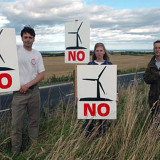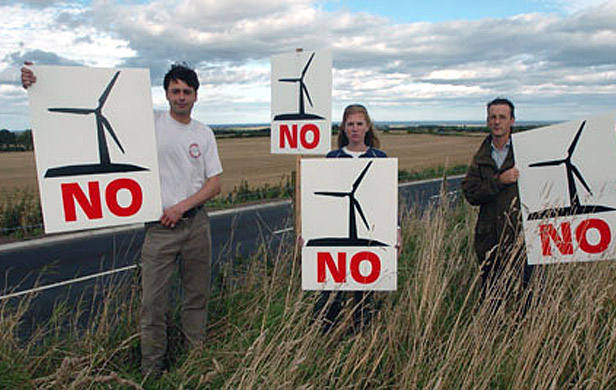I have a cabin on Quadra Island off the British Columbia coast that’s as close to my heart as you can imagine. From my porch you can see clear across the waters of Georgia Strait to the snowy peaks of the rugged Coast Mountains. It’s one of the most beautiful views I have seen. And I would gladly share it with a wind farm.
Sometimes it seems I’m in the minority. Across Europe and North America, environmentalists and others are locking horns with the wind industry over farm locations. In Canada, opposition to wind installations has sprung up from Nova Scotia to Ontario to Alberta to B.C. In the U.K., more than 100 national and local groups, led by some of the country’s most prominent environmentalists, have argued wind power is inefficient, destroys the ambience of the countryside and makes little difference to carbon emissions. And in the U.S., the Cape Wind Project, which would site 130 turbines off the coast of affluent Cape Cod, Massachusetts, has come under fire from famous liberals, including John Kerry and the late Sen. Edward Kennedy.
[quote]We can’t shout about the dangers of global warming and then turn around and shout even louder about the “dangers” of windmills.[/quote]
We can’t have it both ways
It’s time for some perspective. With the growing urgency of climate change, we can’t have it both ways. We can’t shout about the dangers of global warming and then turn around and shout even louder about the “dangers” of windmills. Climate change is one of the greatest challenges humanity will face this century. Confronting it will take a radical change in the way we produce and consume energy – another industrial revolution, this time for clean energy, conservation and efficiency.
We’ve undergone such transformations before and we can again. But we must accept that all forms of energy have associated costs. Fossil fuels are limited in quantity, create vast amounts of pollution and contribute to climate change. Large-scale hydroelectric power floods valleys and destroys habitat. Nuclear power plants are expensive, create radioactive waste and take a long time to build.
Royal Society: Wind farms have ‘negligible’ impact on birds
Wind power also has its downsides. It’s highly visible and can kill birds. But any man-made structure (not to mention cars and house cats) can kill birds – houses, radio towers, skyscrapers. In Toronto alone, an estimated one million birds collide with the city’s buildings every year. In comparison, the risk to birds from well-sited wind farms is low. Even the U.K.’s Royal Society for the Protection of Birds says scientific evidence shows wind farms “have negligible impacts” on birds when they are appropriately located.
Improved technologies and more attention to wind farm placement can clearly reduce harm to birds, bats and other wildlife. Indeed, the real risk to flying creatures comes not from windmills but from a changing climate, which threatens the very existence of species and their habitats. Wind farms should always be subject to environmental-impact assessments, but a blanket “not in my backyard” approach is hypocritical and counterproductive.
Wind power costs comparable with other energy sources
Pursuing wind power as part of our move toward clean energy makes sense. Wind power has become the fastest-growing source of energy in the world, employing hundreds of thousands of workers. That’s in part because larger turbines and greater knowledge of how to build, install and operate them has dramatically reduced costs over the past two decades. Prices are now comparable to other forms of power generation and will likely decrease further as technology improves.
Eye of the beholder
But, are windmills ugly? Mostafa Tolba, executive director of the UN Environment Programme from 1976 to 1992, told me belching smokestacks were considered signs of progress when he was growing up in Egypt. Even as an adult concerned about pollution, it took him a long time to get over the pride he felt when he saw a tower pouring clouds of smoke.
Our perception of beauty is shaped by our values and beliefs. Some people think wind turbines are ugly. I think smokestacks, smog, acid rain, coal-fired power plants and climate change are ugly. I think windmills are beautiful. They harness the wind’s power to supply us with heat and light. They provide local jobs. They help clean air and reduce climate change.
And if one day I look out from my cabin porch and see a row of windmills spinning in the distance, I won’t curse them. I will praise them. It will mean we’re finally getting somewhere.



Wind “power” – the first part is true, the second part, maybe…
Germany, last week (17Nov2014) had a cold night… For 16 hours, Wind “power” generated less than 1 GW, yet Germany has 46GW of installed “capacity”… When the sun came up, the solar “power” didn’t pan out, either. Of more than 28GW of solar “capacity” – the maximum generated that day was less than 3GW. The demand for power was 50GW, peaking to more than 75GW. Wind and solar just don’t cut it. The installed “capacity” is taken from an EIA website from 2012, so I’m sure Germany has more installed “capacity” since 2012, but the power produced was taken from a web site today,
http://www.agora-energiewende.org/service/recent-electricity-data/
“… one has to free oneself from the illusion that international climate policy is ENVIRONMENTAL policy. Instead, climate change policy is about how WE redistribute de facto the world’s wealth…” words of Ottmar Edenhofer, IPCC official.
Windmills are popular because people think that burning fossil fuels for electrical power generation is killing the planet. Well, the quote, above, tells you that all this planet-killing fuss is fake, it is really all about redistributing wealth… not at all about environmental stuff. The burning of fossil fuels used to be a really dirty process, and it was done by people who didn’t care about the pollution… we fixed that. We fixed it so well, so fast, we took away most everything for them to cry about, so they invented a new boogieman…. carbon dioxide. The old dirt, stuff like sulphur dioxide, nitrogen oxides, soot particles… that was real dirt, real bad. We cleaned all that up. This noise about carbon dioxide is just that, noise…. so those crying so loud can steal the wealth from some, and hand it out to others (keeping large amounts for themselves, as they skim off the top)…
The fruit fly doc’s article emblazons this quote: We can’t shout about the dangers of global warming and then turn around and shout even louder about the “dangers” of windmills.”
– Fine, then, Doc Fruitfly. Let’s stop shouting about the dangers of global warming… after all, the globe ain’t warming any more, hasn’t for 17 and a half years (by several measures). The “corn belt” of the USA shows no warming for about forty years. Let’s look at the hazards of windmills… they cost too much, the power they generate is not ‘dispatchable’ (it is hard to regulate the surges and sags of power made by the weather). The blades not only kill bats, they are especially good at killing birds of prey, the same birds y’all cried over when their eggshells were supposedly thinning due to DDT. What, now that they aren’t threatened by DDT, killing them is okay now?
Ronda Zwierz, have you considered the land area that is necessary to produce power from weather (wind, sun)? There are many reasons why weather-power is not practical, and one of them has to do with density… how many acres of land you have to dedicate. Nuclear and fossil-fuel electrical generation facilities have a small land-area requirement.
Little devices that generate little power, have their own problems. Efficiencies scale with size quite nicely; so do costs. A lot of lithe generators will end up with really giant inefficiencies! I thought the whole idea was to use less fuel to generate the same power? Miniature devices make maximum waste. There is a big difference between the way microelectronic devices keep shrinking and improving (and using less power) compared to other things that don’t have the advantage of shrinkable microchip size. For example, wind turbines… or photovoltaic solar cells… for each of these, larger size means the ability to gather larger power from the available weather. Unless the sun gets a lot brighter, or the wind, a lot stronger, there won’t be much shrinking of weather-powered electrical generators… Sure, photovoltaics are only 10% to 20% efficient right now, so maybe they could double or triple in productivity, but not 10x or 100x or 1000x as microchips have. California’s wonderful weather site, called the CVSR, takes up 1,500 acres, with the best available photovoltaics, and produces 250MWe in peak sunshine (and guess what, it shuts down at night!… it produces only 22% of that 250MWe, on average, over a year. A 250MWe natural gas, turbine generator station would produce more than twice that power (over an average year) and take up about a tenth of the space. It would cost a lot less, too. Look at Germany; their electricity costs went from 0.20 to 5.28 from the year 2000 to 2013 as they put in outrageous amounts of weather power, and shut down their nuclear plants. What are they doing now? They are not walking, but RUNNING away from weather-power, commissioning COAL fired power plants as fast as physically possible! You want us to go do what Germany has decided to run away from? WHY?
Twenty years ago Mosaic (the first internet browser) had just recently been released and there were about 600 web sites world wide. If you had a cell phone, it was slightly smaller than a brick and it only made phone calls. There were no apps for anything!
If we put that kind of ingenuity into wind, solar, wave, geothermic and other sustainable sources of power, twenty years from now fossil fuels will be a dying commodity.
We also have to move away from the mindset that we need huge power plants. Just like mainframe computers had their day, those big power plants can be replaced with individual devices that each create a little power. Each person, or business, will buy devices appropriate for their needs. No different from buying the type of toaster you like now.
Thirty years from now school kids will be laughing at us. “They dug poison out of the ground and burned it?” Some of them will have good jobs cleaning up our mess.